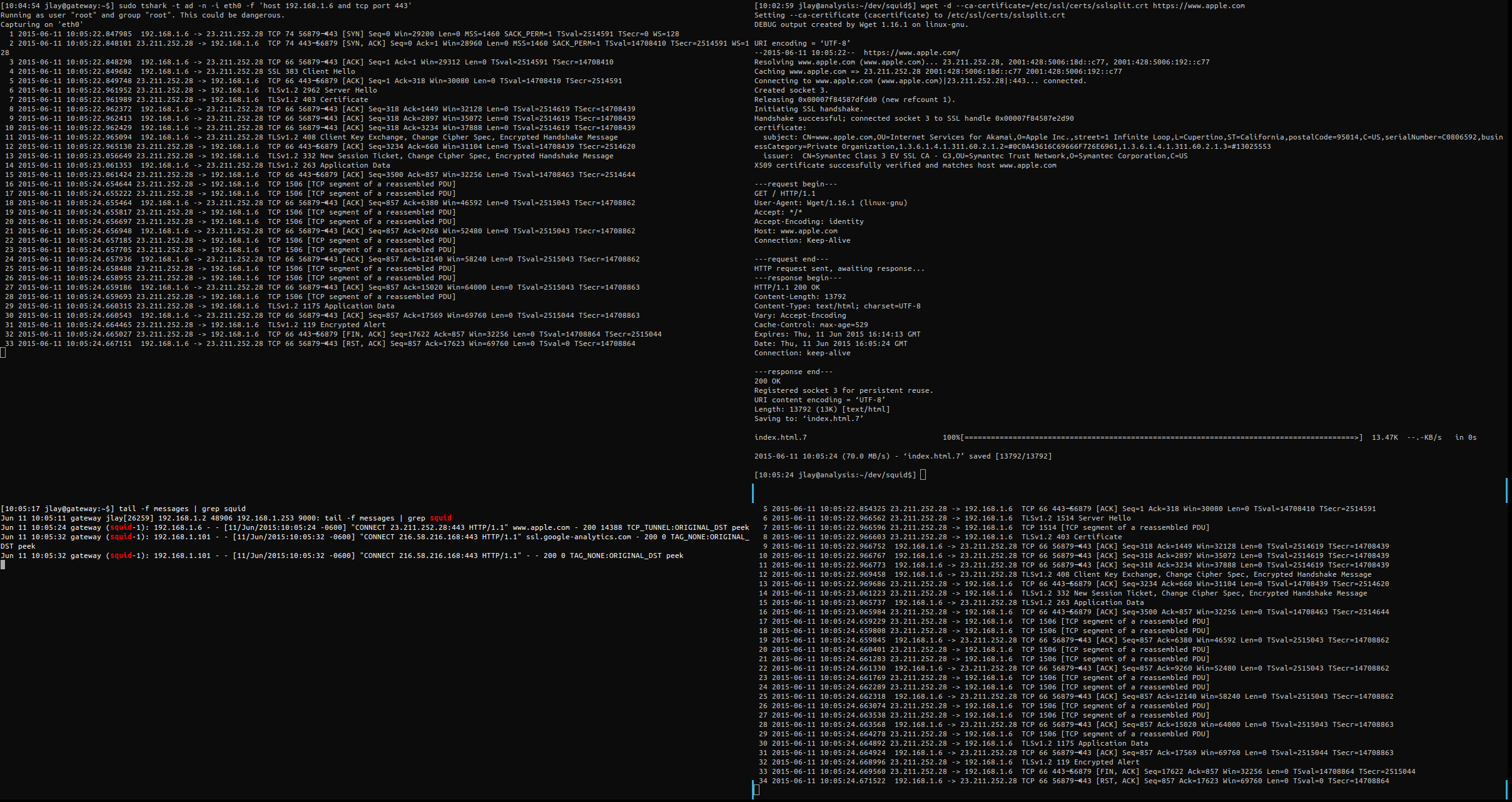So....here's what I have for filtering http and https in the same instance. This is using iptables with -j REDIRECT lines. Below is my entire squid.conf, documented as well as I can:
#allow local network to connect to squid
acl localnet src 192.168.1.0/24
#safe ports are 80 and 443 in one acl, port 443 is another acl
acl SSL_ports port 443
acl Safe_ports port 80
acl Safe_ports port 443
#allow the http CONNECT method
acl CONNECT method CONNECT
#our regex list of sites and domains that we allow ie, www\.apple\.com and \.google\.com
acl allowed_http_sites url_regex "/opt/etc/squid/http_url.txt"
#we don't want to allow anything besides port 80 and port 443
http_access deny !Safe_ports
#we don't want CONNECT if we're not going to port 443
http_access deny CONNECT !SSL_Ports
#since we may not know the https site we're going to (ie connect direct by IP), we must initially allow all https
http_access allow SSL_ports
#we allow http, but only sites and domains in our regex http_url.txt list above
http_access allow allowed_http_sites
#drop any other http requests that are not in our regex http_url.txt list above
http_access deny all
#break out the ssl_bump process by steps
acl step1 at_step SslBump1
acl step2 at_step SslBump2
acl step3 at_step SslBump3
#look for site or domain name either by SNI in request (step1), or server subject in certificate in response (step2)
ssl_bump peek step1 all
ssl_bump peek step2 all
#see if the server name we obtained from the previous peek's above are in our http_url.txt list above
acl allowed_https_sites ssl::server_name_regex "/opt/etc/squid/http_url.txt"
#if the server name is in our http_url.txt, allow it
ssl_bump splice step3 allowed_https_sites
#if the server name is not in our http_url.txt terminate the handshake it
ssl_bump terminate all
#cert path and allow all the ssl options
sslproxy_capath /etc/ssl/certs
sslproxy_options ALL
#standard crtdaemon options
sslcrtd_program /opt/libexec/ssl_crtd -s /opt/var/ssl_db -M 4MB
sslcrtd_children 5
#intercept 3128 for port 80, and 3129 for port 443. Cert, cacert (these are the same, read on the list this fixed an issue), and key, generate ssl certs
http_port 3128 intercept
https_port 3129 intercept ssl-bump cert=/opt/etc/squid/certs/sslsplit_ca_cert.pem cafile=/opt/etc/squid/certs/sslsplit_ca_cert.pem key=/opt/etc/squid/certs/sslsplit_ca_key.pem generate-host-certificates=on dynamic_cert_mem_cache_size=4MB sslflags=NO_SESSION_REUSE
#normal-ish log format, but we want to see the SNI, server cert subject, and how we are bumping
logformat mine %>a %[ui %[un [%tl] "%rm %ru HTTP/%rv" %ssl::>sni %ssl::>cert_subject %>Hs %<st %Ss:%Sh %ssl::bump_mode
#log the above format name (mine) to syslog
access_log syslog:daemon.info mine
refresh_pattern -i (cgi-bin|\?) 0 0% 0
refresh_pattern . 0 20% 4320
coredump_dir /opt/var
One caveat I've seen so far is that I have only seen is I only ever see peek in the logs, though I know it's been spliced as shown below:
[09:35:19 jlay@gateway:/opt/etc/squid$] grep textnow http_url.txt
api\.textnow\.me
[09:34:57 jlay@gateway:~$] dig api.textnow.me
<snip>
;; ANSWER SECTION:
api.textnow.me. 600 IN A 209.59.180.48
>From the client:
[09:34:27 jlay@analysis:~/dev/squid$] openssl s_client -connect 209.59.180.48:443
CONNECTED(00000003)
depth=1 C = US, ST = Arizona, L = Scottsdale, O = "GoDaddy.com, Inc.", OU = http://certificates.godaddy.com/repository, CN = Go Daddy Secure Certification Authority, serialNumber = 07969287
verify error:num=20:unable to get local issuer certificate
verify return:0
---
Certificate chain
0 s:/OU=Domain Control Validated/CN=*.textnow.me
<snip>
GET / HTTP/1.1
HTTP/1.1 200 OK
Server: nginx
Date: Thu, 11 Jun 2015 15:36:54 GMT
Content-Type: text/plain
Transfer-Encoding: chunked
Connection: keep-alive
X-Powered-By: PHP/5.5.16
Expires: Thu, 01 Jan 1970 00:00:00 GMT
Cache-Control: no-cache, no-store, must-revalidate, max-age=0
Server Squid log entry:
Jun 11 09:36:55 gateway (squid-1): 192.168.1.6 - - [11/Jun/2015:09:36:55 -0600] "CONNECT 209.59.180.48:443 HTTP/1.1" - - 200 364 TCP_TUNNEL:ORIGINAL_DST peek
I also notice that the CN does not show up in the logs...it WAS spliced however because it matches our http_url.txt. From the above, it appears that only the step1 is getting logged. The below log entry was used with wget (sends SNI by default):
Jun 11 08:51:05 gateway squid: 192.168.1.6 - - [11/Jun/2015:08:51:05 -0600] "CONNECT 23.211.252.28:443 HTTP/1.1" www.apple.com - 200 14388 TCP_TUNNEL:ORIGINAL_DST peek
The above shows that I logged and retrieved my SNI at step1....the subsequent splice was not logged. I still note that terminates do not get logged ( I have a bug open for that but I think the core bug may be that when using atStep you only see step1 regardless, but I could be wrong). I'm enclosing an image of what a https terminate looks like from the server and the client (msn.com isn't in the http_url.txt), and also what an https allow looks like (apple.com is in the list).
That's it. I can verify that the above works for a single list of allowed hosts(www.apple.com) and domains (google.com). If there's something I missed...something wrong...ways to improve...ANYTHING for the betterment of Squid users please don't hesitate to jump in here. Thank you.
James
_______________________________________________ squid-users mailing list squid-users@xxxxxxxxxxxxxxxxxxxxx http://lists.squid-cache.org/listinfo/squid-users


